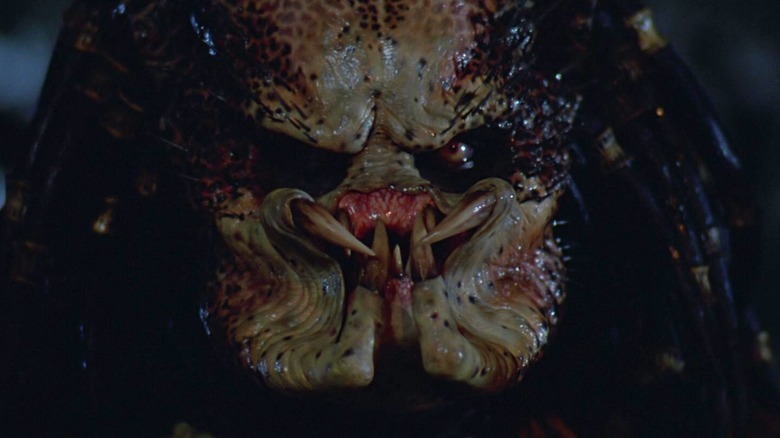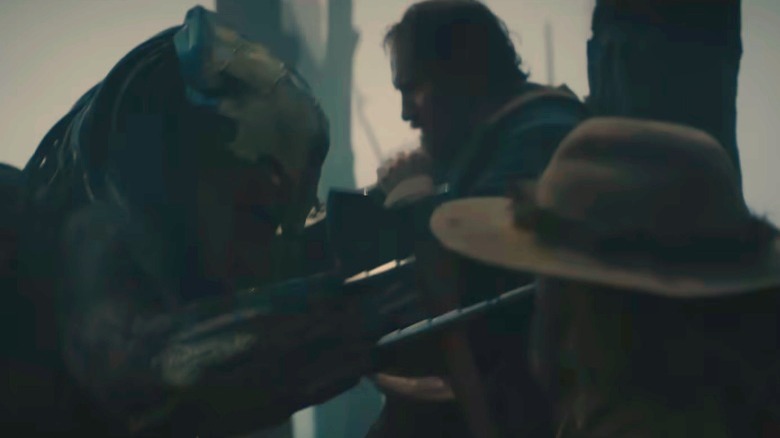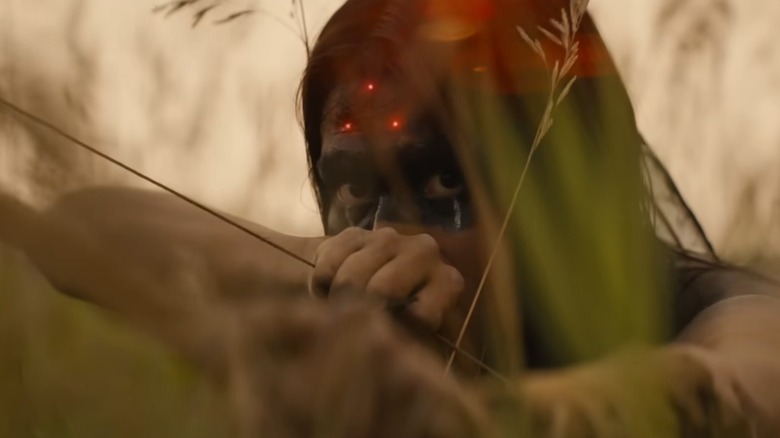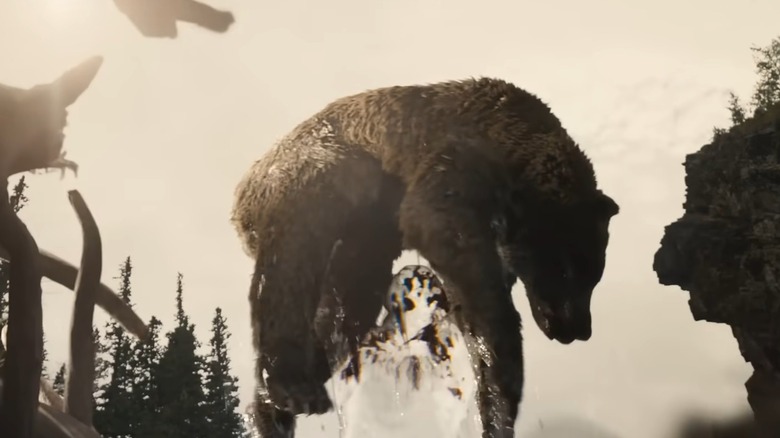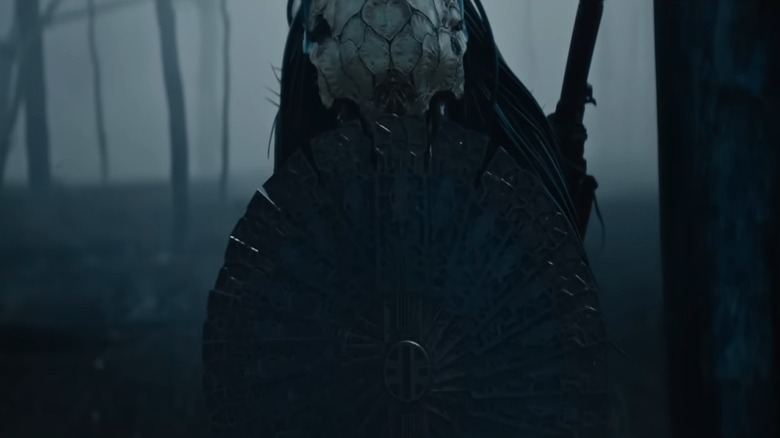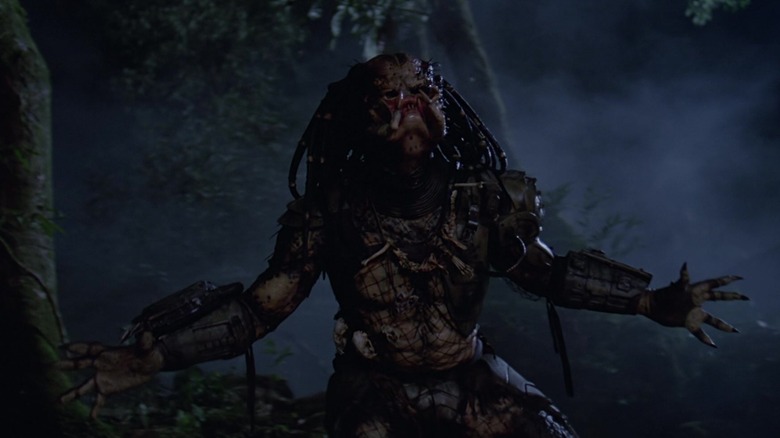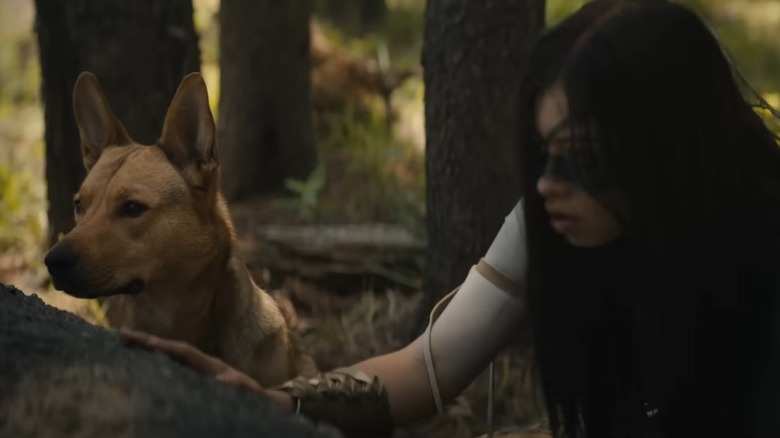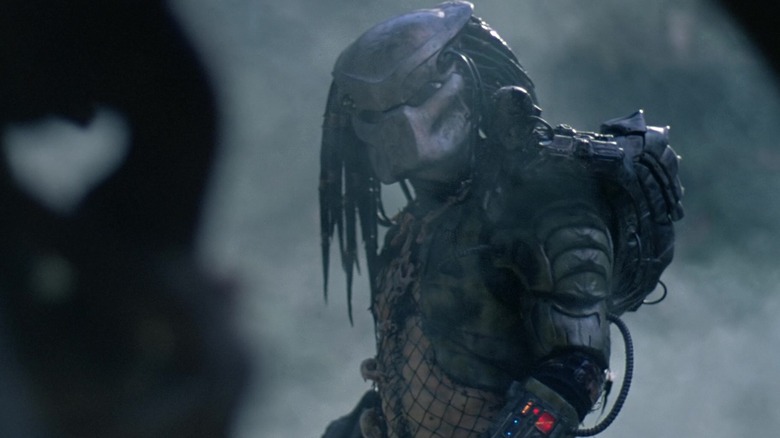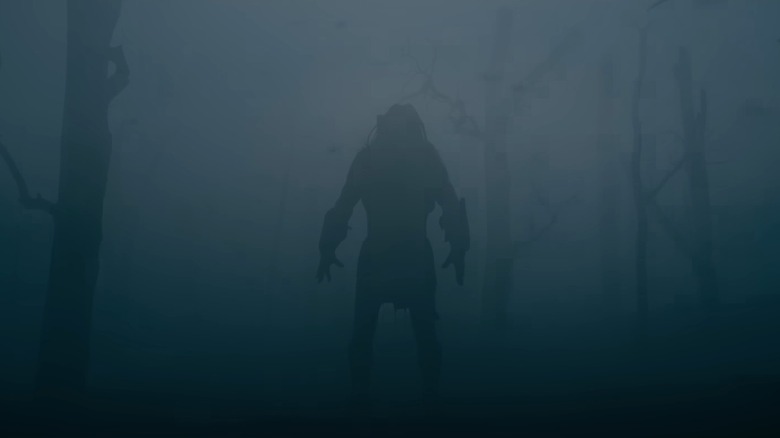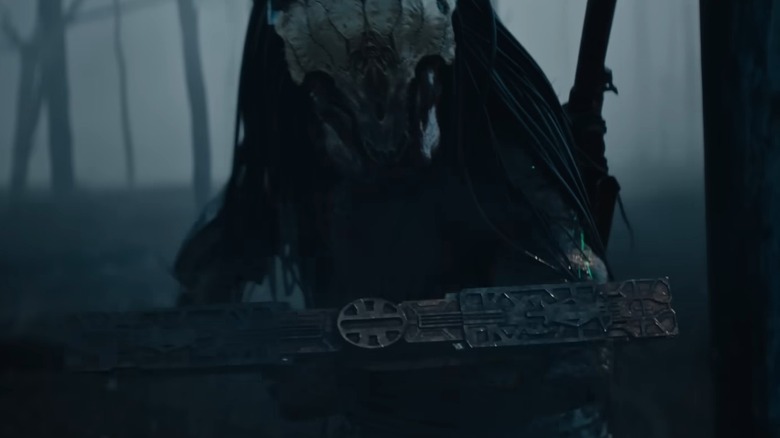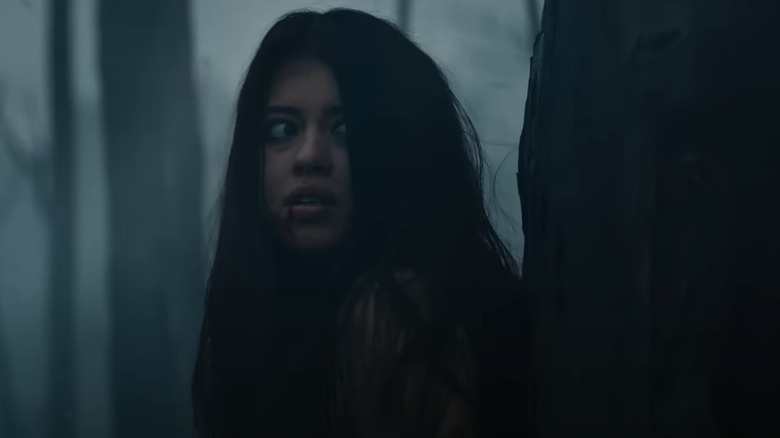The Predator's Biggest Differences Between Prey And The Predator Movies
An intergalactic alien hunting down humans — it's a film premise that's guaranteed to work every time. The "Predator" franchise certainly believes in it wholeheartedly, as the dreadlocked Yautja with a mouth straight out of a Stephen King novel returns for another spine-ripping adventure in Hulu's "Prey." Directed by Dan Trachtenberg of "10 Cloverfield Lane" fame, and starring Amber Midthunder, Dakota Beavers, and Stormee Kipp, this sci-fi film finds a new hunting ground in the 1700s Comanche Nation. More importantly, the distinction between who is the hunter and who is the prey gets intentionally blurred here.
Since the Predator's ship in "Predator 2" has artifacts and weapons spanning many times and cultures, a "Predator" film can really pit the creature against any group of humans. Setting the action of the "Predator" prequel in the past not only creates a different narrative stream for the franchise but also provides an opportunity to explore the Predator's history and answer questions that fans might have about the creature: Were its weapons always this advanced? Does it consider any other creatures on Earth as worthy opponents? Now, keep in mind that the Predator canon is about as loose as that of any comic book publisher after years of infinite crises and civil wars, so there's no promise these discoveries are binding and permanent in this universe. Still, that doesn't mean we can't have some fun with them and notice what's changed across the films. So let's make that weird clicking noise and find out the Predator's biggest differences between "Prey" and the "Predator" movies.
The Predator relies less on high-tech gadgetry
Hunters don't step out into the hunting grounds without any sort of preparation. They bring their arsenal of weapons along with them, ensuring they have everything they need to take down their intended targets. In "Prey," however, this Predator prefers to travel light when vacationing on Earth. While it uses its invisibility cloak mode better than Harry Potter and everyone at Hogwarts, the creature doesn't rely on its gadgetry as much as it has in other films. That isn't to say all the high-tech alien weapons are absent, but merely that it prefers to stab and impale its prey rather than blast them to smithereens.
Since the film does take place 300 years ago (as per the official synopsis), it's likely this version of the Predator might also not be fully evolved in the weapons department. Yes, it's certainly far more advanced than humanity at this stage, but it doesn't appear to have all the tricks and upgrades of the Preddy from, say, "Alien vs. Predator." More importantly, this makes it a fair contest between the humans and the alien creature since it isn't cheating by spamming its arsenal for options. Although, it would be interesting to witness how the creature fares without the use of its cloak technology at all, since that still allows it to sneak up on humans. Animals, at least, can sniff the creature out, even if they can't see the Predator.
The alien is as effective in an open plain as in a confined space
The success of John McTiernan's "Predator" film can be attributed to its survival horror elements. Dutch and his team are out in a jungle, but all the trees surrounding them and constricting the space puts them at the mercy of the alien whose use of camouflage and the environment makes them sitting ducks. Similarly, other "Predator" movies (especially the good ones that try to honor the original) rely on this key element, as it gives the alien a place to hide, sneak, and strike from. To borrow a Terry Silver quote from "The Karate Kid Part III": "If a man can't see, he can't fight."
While "Prey" has similar situations to the first "Predator" where there are moments of confinement, it also poses a new question: How good is the creature in open spaces? The Great Plains boast vast amounts of open land with only grass in the distance. In theory, this would be the best place to lure the alien creature to, since it removes the high ground aspect and lets any sudden movements (even in cloak mode) be more identifiable. However, "Prey" confirms the creature is as lethal in this setting as in others. One especially memorable scene finds the beast chasing Naru (Amber Midthunder) and her brother (Dakota Beavers) across an open field, a set piece reminiscent of the velociraptors stalking the hunters through the long grass in "The Lost World: Jurassic Park" – if the raptors were invisible.
The creature isn't only hunting humans
The Yautja hunt other life forms for both sport and pride, claiming ritualistic trophies from their victories. They want to prove their superiority — quite often in the most brutal way imaginable — while still maintaining a code of honor for their prey. This code is questionable, though, since it isn't ever a fair fight if the opponent fails to have an activated cloak mode or intergalactic weapons in their possession. So let's say their moral compass is a bit skewed toward the hypocritical side.
In other "Predator" films, the audience witnesses the Yautja go after humans as their main target, identifying them as worthy adversaries. Ironically, humans aren't even considered apex predators in our own world, since we don't eat everything we destroy (per Live Science). In "Prey," the Predator goes after several creatures — not just humans. It faces off in two big contests against a wolf and bear. The wolf shows its nose is key in this encounter; however, it proves to be no match for the Predator's sharp blades. On the other hand, the bear strikes some real blows on the creature. If the Predator's cloaking ability had been removed, there's a good chance it might struggle to deal with a bear's sheer power. Moral of the story? Baloo the Bear versus the Predator in a fair fight might be the crossover we all need to see.
The Predator looks starkly different
Next to its age-old nemesis (and Ellen Ripley's least-favorite thing in the universe), the Xenomorph, the Predator's design is one of cinema's most distinctive and iconic looks, especially in the creature feature department. From the trademark dreadlocks to the ugly mug only a mother could love, it isn't too hard to point the universe-traversing hunter out in a lineup. However, in "Prey," the Predator looks a little different from before, showcasing a leaner gladiator aesthetic. While it's still easily identifiable as a Yautja, it did receive a makeover with a few tweaks to its physical appearance that fans noticed immediately.
Dan Trachtenberg spoke to Time Out and explained why he felt it was necessary to change the creature's appearance for the film. "I wanted to make sure the head was more proportional to the body," he said. "This Predator is much slimmer and less armored than it's ever been. It's more 'creature.' It's still hulking and ferocious."
At San Diego Comic-Con, Trachtenberg revealed he and his team also included goop around the Predator's face to make it more disturbing to look at (via ComicBook.com). At the same time, it also serves as a great tip of the hat to "Alien" and all of its gooey goodness.
The Predator struggles with environmental challenges
In "Predator 2," the creature navigates a concrete jungle with relative ease and fluidity. Despite the unique surroundings of Los Angeles and its abundance of glam rock bands trying to get us to go to their shows, it understands what it needs to do to hunt and survive in this setting. The reason for this is likely due to the events of "Prey," which serve as an important lesson for all the other Yautja of what not to do when on Earth. In fact, no one would be too surprised if the Predators made memes and jokes about their fellow alien's glorious fails on our planet.
In "Prey," the Predator falls into a quicksand trap, which ultimately plays a major part in its downfall. Like anyone else in such a pickle, it struggles to get out of this situation (granted, it had been injured beforehand, which made its predicament slightly worse), but it does lead one to wonder if quicksand didn't exist on any of the other planets it visited before. Alternatively, it's possible that this Predator is still young and inexperienced in its hunts. Maybe Earth is its first rite of passage and it's trying to prove itself, quickly and recklessly. It would also explain why the creature fights the bear in the river, when the water isn't conducive to its cloak mode's effectiveness and helps to reveal its presence.
The creature is outfoxed by a dog
Think about all the "Predator" films for a split second. The creature has taken on many formidable foes who have proven to be worthy adversaries (and even victors). From the terrifying Xenomorph to the walking muscle mountain known as Dutch Schaefer (Arnold Schwarzenegger), the alien hunter has faced off against the best of the best across the planet. In "Prey," the Predator gets too cocky for its own good, determining who and what is a threat and isn't. And it isn't only Naru whom he takes for granted in battle, but also her dog.
While the creature manages to put down a wolf, bear, and countless other human beings along the way, it falls in the end to the outstanding teamwork between Naru and her ruff 'n' tough dog. Truth be told, one could argue it is the pup that makes the difference here, as Naru is left exposed in the final fight against the Predator on two occasions. The first time, the dog leaps onto the creature as the Comanche warrior appears done for, forcing it to miss. Then, the four-legged best friend appears with an ax when Naru needs it most. After the warriorlike efforts, it's about time we receive a spin-off story for the true hero of this story. All hail dog!
The Predator experiences a quiet surrounding
Remember what the world's greatest hunter, Elmer Fudd, said when it was wabbit season? "Be vewy, vewy quiet." Many hunters will say this is the key to successfully capturing their prey, since it helps to maintain the element of surprise and to strike hard and fast — without mercy, of course. In the previous "Predator" movies, silence hasn't always been golden. While everyone tries to keep their lips zipped and mobile phones on silent when in danger, it isn't always possible as groups of people tend to want to talk — even when the imminent threat of total annihilation looms near. So while they might tone it down for brief moments and avoid putting their boots on sticks and broken branches, they struggle to do so for long stretches of time.
On the other hand, "Prey" is a quiet film. Besides the occasional bird chirp or rustle of the leaves, there's a stillness and quietness to the Great Plains. It's ideal for the Predator, for sure, as the silence ensures the creature will be able to hear the footsteps of its prey from a mile away. However, it's equally effective for the intended victim, too, since any sudden movement will alert them of a problem on the horizon. As an example, Naru manages to find and attack the unaware Predator simply because she's quieter than the alien. Talk about using the hunter's tactics against them.
The creature's more ferocious than horrific
There's an argument to be made that the "Predator" franchise falls firmly under the umbrella of horror film. After all, the whole concept of an almighty alien hunter chasing after humans is frightening — plus, the creature's unmasked face is pure nightmare fuel. However, it's also in the presentation of the previous films, since they're jam-packed with jump scares and never knowing what's lurking around every corner and bend. In "Prey," the scary elements remain, especially in the look of the character and the odd jumpscare or two, but there's something different about this version of the Predator: It's far more savage than before. Seriously, it even chucks a bear trap at a human at one point.
This alien creature uses its raw power and lightning speed to wicked effect. It moves with a resolute purpose and uncanny brutality that has been found lacking in the past few movies. While some might say this is a key element of the slasher subgenre of horror, the Predator isn't coming at people through their nightmares or hiding behind doors and walls. There are scenes where the Predator steps into the picture and decimates everyone without much fuss. It doesn't hide in the shadows like a boogeyman; instead, it charges into battle like a warrior that isn't afraid of anything. To make a comparison, consider the Predator as more Brock Lesnar than The Undertaker here.
The alien devises its own demise
Play any RPG video game and one thing is clear: the better your class of weapons, the better your chances of success. The Yautja must be fans of the "Fallout" video game series as well, since they love to bring an arsenal to a knife fight. In the previous "Predator" films, the shoulder cannons have made all the difference in battle. In "Prey," the creature prefers to use hand-to-hand combat to dispose of its opponents, but it isn't averse to pulling out the big guns when absolutely necessary.
While stuck in the quicksand — with nowhere left to go and not entertaining the possibility of self-destruction — the Predator points its weapon at Naru and fires. However, it fails to realize its helmet, which features its targeting capabilities, is off. It also didn't spot that Naru carefully set up the helmet to lock the Predator in its crosshairs. As a result, the creature ends up on the receiving end of its own attack. It feels an awful lot like Wile E. Coyote watching his dastardly plan for the Road Runner backfire on him. Again, it proves that tech is nice for any fight, but a strategist will always trump an aggressive brute in the end. Naru 1, Predator 0.
The Predator underestimates its biggest threat
Consistent across the "Predator" franchise is that the extraterrestrial Yautja believe in a warrior's code. They don't hunt for a tasty snack or self-defense from someone trying to nick their wallets. Instead, they take on opponents they believe will provide a tough, daunting challenge — or would make excellent sparring partners, like in the Yakuza swordfight in "Predators." For the Yautja, it's about testing their superior skills and advanced smarts as they attempt to prove they are worthy enough to be a part of their clan. Throughout the "Predator" films, this code seems to be largely intact as they stop just short of fist-bumping their victims before the end. However, "Prey" presents an interesting question: What if the alien isn't as good at identifying threats or challengers as we presume them to be?
Undoubtedly, the Predator sees the Comanche warriors as worthy enough to challenge and hunt. It stalks and battles them, coming out on top on several occasions. However, the creature fails to see the threat of Naru from the get-go. She demonstrates a warrior spirit and natural fighting ability, even if some of her own people doubt her skills, but the Predator basically scoffs at the thought of taking her on. Naru's resilience and ingenuity prove to be too much for the alien hunter in the end, as she brings him down in combat. Imagine how different it could have been had the creature not underestimated her. Let that be a lesson to the Predators out there that no one puts Naru in the corner.
